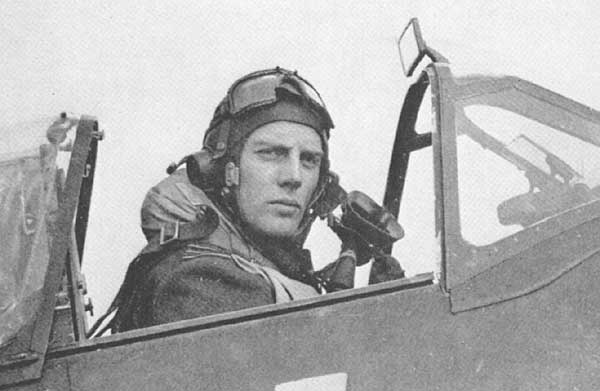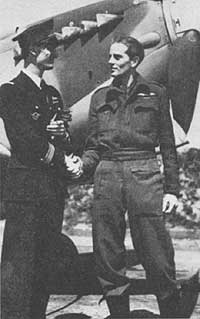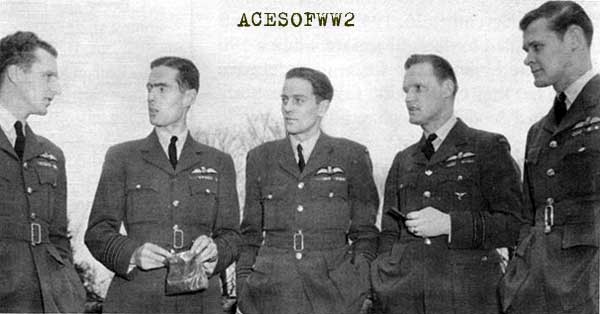

________________________________________CHARLES, F/O
Edward Francis John (36198) - Distinguished Flying Cross
- No.54 Sq. This officer has displayed exceptional zeal and immense enthusiasm during the many offensive sweeps carried out by his unit. He has destroyed at least three enemy aircraft. _____________________________________________
____________________________________________ SASKATCHEWAN PILOT GETS FOUR NAZIS IN FOUR DAYS
|
Today's kill brought Charles' score
to 11½ destroyed and 6½ probables and followed a busy
weekend in which Charles shared with a Fighting French squadron
commander [S/L Rene Mouchotte] a sweepstakes purse of approximately
$1,500 for shooting down the 1,000th enemy plane in his sector. Each destroyed a Nazi aircraft so close together it was impossible to tell which was the 1,000th and which was No 999, so the pilots split the prize money. Operations in the last four days boosted the sector's total to 1,012 aircraft destroyed. Friday morning Charles scored the first of his run of four kills, bringing the sector's total to 966. "I was leading the squadron and saw this Jerry below me," said the 24-year-old pilot. "I dived under him and then came up and opened fire at about 220 yards, closing to almost 50. The enemy aircraft turned on its back and I last saw him going straight down." |
 |
_____________________________________________
_____________________________________________________
London, June 24, 1943 —(CP Cable)—
A Canadian squadron leader, who shared last month in his sector's destruction
of its 1,000th enemy aircraft, blasted a Focke-Wulf out of the sky Wednesday
while participating in the escort of R.A.F. medium bombers which attacked
Meaulte in Northern France.
The Canadian, Sgdn.Ldr. E. F. J. Charles, of Lashburn, Sask., scored one
of two victories against the Nazi defenders.
"There was a series of dogfights when a number of the enemy attacked
us at 20,000 feet," Charles said. "I saw one above me and gave
him a burst. I could see parts of the aircraft break away. It burst into
flames after falling 2,000 feet."
Canadian headquarters said laconically that "Canadian Spitfire squadrons"
had assisted the R.A.F. bombers as escorts.
_____________________________________________________
CHARLES, S/L
Edward Francis John (36198) - Bar to DFC
Awarded as per London Gazette dated 15 July 1943 and
AFRO 1949/43 dated 24 September 1943
This officer is a first class fighter whose fine leadership, cool judgment and efficiency have set an admirable example. He has destroyed thirteen enemy aircraft and damaged several more.
_____________________________________________________
Ottawa, July 13, 1943 (CP) — R.C.A.F. headquarters
announced Saturday the award of a bar to the Distinguished Flying Cross
to Sqdn.-Ldr. E. F. J. Charles, Lashburn, Sask., and of the Distinguished
Flying Cross to F/O J. E. McClure of London, Ont.
The citation for Sqdn.-Ldr. Charles said: "This officer is a first-class
fighter whose fine leadership, cool judgment and efficiency have set an
admiral example. He has destroyed 13 enemy aircraft and damaged several
more."
F/O McClure's citation said: "This officer has completed much operational
flying, including a number of reconnaissances and attacks on shipping.
In attacks on enemy lines of communication, F/O McClure has destroyed
four locomotives and damaged several more. In addition, he has destroyed
a barge and caused damage to rolling stock. F/O McClure has displayed
skill, keenness and determination of a high order."
_____________________________________________________
CHARLES, S/L
Edward Francis John (36198) - Silver Star (U.S.) - No.611
Squadron
Awarded as per London Gazette dated 20 July 1943 and
AFRO 2049/43 dated 8 October 1943
Public Record Office Air 2/9599 has citation as published in
General Order No.104 Eighth Air Force, 16 July 1943
For gallantry in action while escorting United States Army Air Force bombers on ten bombardment missions over enemy occupied territory. Squadron Leader Charles has led his squadron brilliantly and with utter disregard for his own personal safety. His actions on all these occasions reflect the highest credit upon himself and the armed forces of His Majesty's government.
____________________________________________________
CHARLES, W/C
Edward Francis John (36198) - Distinguished Service Order
Awarded as per London Gazette dated 29 October 1943 and
AFRO 2457/43 dated 26 November 1943
Described him as a Canadian in the RAF. Air Ministry Bulletin 4508
refers
Wing Commander Charles is an inspiring leader whose great skill and tenacity have contributed materially to the successes obtained by the formations with which he has flown. In September 1943 he led a formation of fighters which acted as escort to a bomber force detailed to attack an airfield in northern France. During the operations twelve enemy fighters were engaged and in the ensuing combat four of the hostile aircraft were shot down, one of them by Wing Commander Charles. This officer, who has destroyed at least fifteen enemy aircraft, has displayed great courage and unflagging devotion to duty.
__________________________________________

Bob Hayward, Leonard Cheshire, Jack Charles,
Fred Green & Jack Sheppard
_______________________________________________
London, Sept. 24, 1943 - (CP) - Canadian flying aces
in some of the most productive aerial fighting since the days of the Battle
of Britain three years ago destroyed five enemy fighters today in widespread
actions over France.
F/O George (Buzz) Beurling of Verdun, Que.,
marked his long-sought return to action by shooting down a Focke-Wulf
190 to raise his score of enemy planes to 30.
Maintaining the blistering pace set by R.C.A.F. night Mosquito fliers,
the Canadian pilots knocked out of the sky 5 of the 20 enemy planes downed
by Fighter Command during the day.
Three of four German fighters shot down Thursday night were victims of
Canadian airmen. F/L M. W. Beveridge of Montreal destroyed two and F/O
J. R. F. Johnson of Omemee, Ont., got one.
Flying with the Wolf Squadron under S/L Norman Fowlow
of Windsor, N.S., Beurling saw the FW-190 above him. He circled and tore
off the enemy's port wing with a single burst.
W/C L. V. Chadburn of Aurora, Ont., and F/L
J. D. Mitchner of Saskatoon shared one of the
day's bag. The others fell to Wing Cmdr. Hugh Godefroy
of Toronto, who has just taken over command of a Canadian fighter wing;
F/L Robert Buckham of Vancouver, leader of the
Red Indian Squadron, and W/C E. F. J. Charles of Vancouver,
who flies with the R.A.F.
Buckham, who also was credited with damaging one plane, blew an FW190
to bits after chasing it from 20,000 feet almost to the ground. It was
his second victory in five days.
In one of the sweeps by Godefroy's squadron - he was squadron leader of
the Wolf Squadron before his new appointment – P/O William F. Cook
of Clinton, Ont., dived his Spitfire to low level to put out of service
a French freight engine, although flak from the train broke part of one
wing.
Beurling had been yearning to get back into combat flying ever since he
was stationed in Malta where he ran his score of enemy planes downed from
two to 29.
He transferred from the R.A.F. to the R.C.A.F. on Sept 1 to "get
back into the air." He had been assigned to an instructor's job in
an R.A.F. gunner school after his return to Britain from a leave in Canada.
__________________________________________
Chris Shores gives the following list of victories: 17 Apr 41, one
Bf.110 destroyed (Spitfire P7756) |
* One of his victims being Horst Hannig, an Ace with 98 victories
________________________________________________
NOTE: On a form dated
11 Sept.'44 he gave his flying hours as |
________________________________________________________
--- Canadian Aces ---
_______________________________________________
On these pages I use Hugh Halliday's extensive research (which includes info from numerous sources), newspaper articles via the Canadian Museum of Civilization Corporation (CMCC) as well as other sources both published and private |